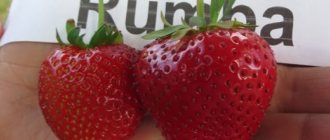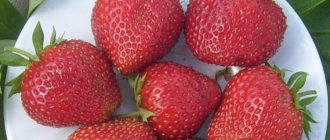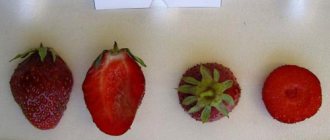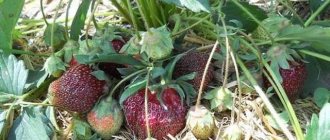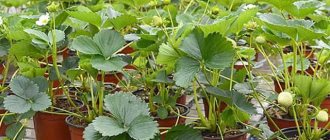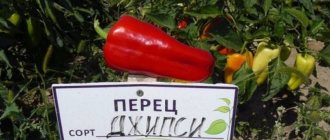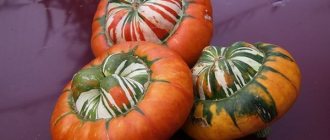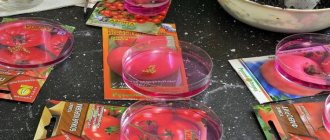Characteristics and botanical description
Strawberries "Rügen" form small berry bushes, the characteristic feature of which is the complete absence of cultivar formation. The berries of this variety of strawberries are bright red in color and oblong in shape. The average length of the berry does not exceed 2-3cm. The diameter of the thickened part is 1.5-2 cm. The pulp is juicy and tasty, characterized by a high iron content. The berries are suitable for fresh consumption and are well suited for making jam, preserves or compote.
Strawberries "Rügen" have erect and strong peduncles that are very reliably able to hold the berries above the ground surface. The variety is resistant to diseases and the formation of genetic changes. The offspring retains the parental characteristics of the mother plant completely.
Growing from seeds
Many gardeners prefer to grow strawberries of the “Rügen” variety from seeds, which involves following the following technology:
- Loose and well-moistened soil mixture with high fertility indicators should be poured into prepared planting containers in the form of boxes;
- Pre-selected and prepared strawberry seeds should be placed at a distance of 4-5 cm between the rows;
- after the seed material is distributed over the soil surface, the planting containers should be covered with plastic film, which does not need to be removed until mass shoots appear.
Planting containers with seedlings should be placed in a bright and fairly warm place. Watering is carried out using a spray bottle with warm water. At the stage of two true leaves, the plant should be pruned. Strawberry seedlings are quite fragile and need careful and careful handling.
The optimal place for planting is the most flat or slightly elevated area, which is reliably protected from gusty winds. It is best to grow strawberries in areas with slightly acidic or neutral soil. Almost any soil that has a sufficient supply of nutrients is suitable for this variety of berry crop. It should be remembered that Rügen strawberries are capable of quickly drawing out the main nutritional components from the soil, so it is not advisable to grow this berry crop in the same area for more than four years.
Pre-sowing seed treatment
Strawberries from seeds are most often grown through seedlings. In this case they use:
- peat tablets;
- individual cups;
- containers.
Since strawberry seeds are very small, they are not planted directly in open ground. To increase the germination of planting material, it is necessary to carry out pre-sowing treatment, which consists of stratification and germination.
Nowadays you can find seeds of various varieties and hybrids of strawberries on the market. When choosing a bag, you must definitely look at the expiration date, since planting material quickly loses its viability and may not germinate a year after ripening and packaging. The number of seeds in the package also varies; some hybrids contain from 4 to 10 seeds.
You can buy different varieties and hybrids of strawberries on the market.
Another option is to collect seeds from your own berries. But if you have several varieties on your site, then they could be cross-pollinated, and your own unique hybrid will grow from the seeds.
Stratification
Seed stratification is a prerequisite for obtaining friendly seedlings. It is carried out both before and after sowing.
The procedure consists of the following steps:
- Strawberry seeds are poured onto a damp cotton pad and covered with a second one.
- Everything is placed in a small food container and stored in a warm place for 2 days.
- Then the container is placed on the bottom shelf of the refrigerator and kept there for another 2 days.
For stratification, strawberry seeds are wrapped in wet wipes or discs and placed in the refrigerator.
- Over the course of two weeks, the seeds are moved either warm or cold. Every day the container is opened and ventilated.
After stratification, the seeds can be sown in bowls, peat tablets, or left in a warm place until roots appear.
Germination
Seeds of especially valuable varieties can be germinated before planting.
- Stratified planting material is laid out on a saucer with a napkin folded in several layers.
- Spray with melt or rain water and place in a transparent plastic bag.
- The package is left in a very bright and warm place with a temperature of 25 °C. Accumulating drops of condensate are removed, and if the bag is dry, the seeds are moistened by spraying.
Seeds of small-fruited varieties that have undergone stratification and are in ideal conditions germinate in a week. If sowing is done incorrectly or if there is a lack of heat and light, seedlings may not appear.
Reviews about the variety
Strawberries "Rügen" belong to the old and time-tested German varieties, producing high yields of very tasty and aromatic berries. Reviews of the variety and their rating are very high. According to gardeners, the varietal feature of the Rügen strawberry is its unpretentiousness, frost resistance and low lighting needs.
Small-fruited strawberries of this variety are deservedly popular among gardeners and summer residents. It combines excellent quality characteristics and commercial appearance. Recently, Rügen strawberries are increasingly grown as an indoor crop and are quite successfully used in flower beds and for decorating artificial lawns and borders.
When growing a berry crop of this variety in home gardening in central Russia, the plants tolerate the winter quite well with a snow cover thickness of 25-30 cm. In light snowy and severe winters, it is recommended to cover the berry plantings with spruce branches or dry leaves.
Landing
Rügen strawberries are planted in slightly shaded areas, as they do not like too much sun. Any soil is suitable - the variety is quite unpretentious. The variety produces the best yield on neutral or slightly acidic soil.
To bring the soil pH to a neutral or slightly acidic level, dolomite flour or other lime fertilizer is added to the soil. Before planting strawberries, the soil is fertilized with organic matter and minerals. Rotted manure, compost (10 kg per square meter), as well as wood ash (200 g per 1 sq. m) and superphosphate (40 g per square meter) are added to the soil. Strawberries are planted according to the following scheme:
- between seedlings – 15-20 cm;
- between rows – 25-30 cm.
Place each bush in a separate hole and sprinkle with earth. The soil around the bush is compacted; the center of the plant is not covered, because there is a heart - the center of growth. Water the bushes abundantly. Watering is continued every other day until the plants are completely established in the new location.
Features of the strawberry variety Rügen
The remontant strawberry Rügen is the most productive variety. With proper care, it can bear fruit throughout the season, until frost begins. The berries have good taste and are therefore suitable for any processing. Fragrant and incredibly sweet fruits are often used to make jam, jam, and compote.
Description of the strawberry variety Rügen
This type of plant belongs to the group of beardless varieties of German selection. As it grows, Rügen forms small bushes with medium-sized leaf blades. This type of strawberry is in particular demand among gardeners. This is due to its unpretentiousness. To grow healthy bushes that will produce a bountiful harvest, you do not need to have special skills.
Benefits of Rügen strawberries:
- good resistance to sudden temperature changes;
- easily withstands short-term droughts;
- tolerates transportation well;
- resistant to diseases.
It is not recommended to grow strawberries in areas where tomatoes and eggplants were located.
This variety is distinguished by juicy berries of a rich red color. All of them have a slightly elongated shape. Their average length is within 2-3 centimeters, and their diameter is 2 cm. The strawberry pulp is juicy. It contains a large amount of vitamins and microelements. Compared to other varieties, Rügen strawberries are rich in iron.
The flower stalks of the plant are erect. They are quite powerful, which allows them to hold berries well above the soil surface.
Strawberry propagation methods and care
There are several options for propagating this type of plant.
Among them, growing Rügen strawberries from seeds is especially popular. This is a labor-intensive but effective method that requires time and patience. In order to distribute the grains evenly over the soil surface, they need to be combined with a small amount of sand.
Strawberry propagation rules:
- Grains should be sown in March or February. If it is difficult to provide additional lighting to the seeds, then it is recommended to postpone this procedure until the beginning of April.
- To get healthy seedlings, you should use only nutritious soil and a container that is not very deep. A wooden box is best.
- Since the grains of this crop are very small, it is not worth sowing them in holes. It will be most effective if the seeds are evenly distributed on the soil surface.
- Then cover the box with polyethylene. Such a mini-greenhouse will allow the substrate not to dry out and maintain the required humidity and air temperature. Place the box itself on the window or take it out onto the balcony.
- It will take several days for the grains to germinate. After the appearance of three leaves, the young plants pick up, and after 6, they move to the beds.
Before planting seedlings, the soil should be prepared. A few days before the procedure, the substrate is limed.
Plants should be planted in open ground at a distance of 30 centimeters. You should not place them any thicker, as next year the bushes will grow and cover the entire garden bed. If you adhere to these indicators, then planting and caring for Rügen strawberries will not be difficult. Even a child can handle it.
It is recommended to plant seedlings only on cloudy days or late in the evening. To make strawberries take root faster, you need to put a little ash or a tablespoon of superphosphate in each hole. Sprinkle the fertilizer with soil and only then place the seedling. In this case, you need to ensure that the growing point is on top of the soil.
You will need to wait a week for young leaves. They will produce their first fruits this same year, but their quantity will be small. The main harvest should be expected next season.
Care
Immediately after planting, the plants need regular watering. However, watering should be moderate; excessive soil moisture should not be allowed! In addition, it is worth remembering about loosening, removing weeds and preventing diseases and pests.
How to fertilize?
Fertilizer can be applied following a certain algorithm:
- In early spring, you need to apply a mineral complex fertilizer;
- After the flower stalks appear, organic fertilizer is applied. You need to dilute mullein 1:6 or chicken manure 1:20, and also add wood ash);
- At the time of flowering, fertilize with cow manure diluted 1:8;
- At the end of summer, you can fertilize with phosphorus-potassium based products. Feed only if the soil is moist. If the weather is dry, you should first water the plants generously. In order not to burn the seedlings, you should apply fertilizer at the root or in the furrows of the bed. Fertilizers should not contain chlorine.
Caring for remontant garden strawberries
The secrets of growing remontant varieties are somewhat different. Basic care methods: it is necessary to regularly add nitrogen and potassium to the soil. Can be used:
- Slurry;
- Herbal fertilizer;
- Humates;
- Compost chatter.
Also an obligatory stage of care is regular but moderate watering. After irrigation, the soil should be loosened so that the root system actively develops.
Leaves that turn red should always be removed. After the first harvest is harvested, all leaves of the plants are removed in such a way as not to affect the growth point of the seedling. Only the leaf blades need to be cut.
Preparing strawberries for winter
Around mid-autumn, strawberries need to be prepared for wintering. All leaves of the bushes are cut off. Plants should be covered with non-woven material, straw or fallen leaves.
Caring for a plant in open ground
In order for strawberries to develop well, you must adhere to some rules. If everything is done correctly and at the right time, then Rügen will certainly please you with a good harvest.
Feeding. Proper care of strawberries involves the use of nitrogen fertilizers. They are extremely necessary, since the quantity and quality of berries depends on such mixtures. Drugs should only be administered in liquid form.
Watering. Irrigation is an important part of care. The bushes need to be watered once every two days. If the air temperature is high outside, the procedure should be carried out every day.
Landing place. It is recommended to grow plants in areas near which, on the one hand, there are fruit trees. This is necessary so that the bushes have sufficient lighting and at the same time are protected from the scorching sun.
You should also pay attention to the leaves. All dry and diseased plates must be cut off, otherwise they will slow down the growth of the plant.
The description of the Rügen strawberry variety once again confirms that this is one of the most popular and fertile types of crop. With proper planting and care, the bushes will always be healthy and will delight you with a good harvest.
Diseases and control methods
The Rügen strawberry variety is resistant to many diseases, although some cannot be avoided. What to do, how to fight:
Spray the plantings with Euparen, Plariz or Alirin B or a garlic and ash solution.
Spraying the plantings and soil with Bordeaux mixture and iodine solution before flowering.
Spraying with preparations containing copper or a solution of serum, iodine, potassium permanganate.
Spraying bushes with iodine solution, garlic infusions, potassium permanganate.
